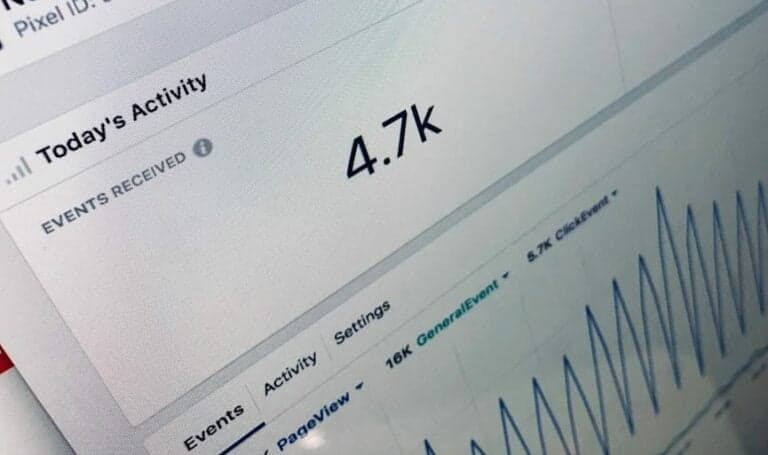Facebook Tracking Pixel is a powerful tool that allows businesses to track user behaviour and gather data for their Facebook ad campaigns. It is a small piece of code that is placed on a website, and it collects information about the actions users take on that site. This data is then used to optimise Facebook ads and improve targeting.
In today’s digital marketing landscape, it is crucial for businesses to have a strong online presence and reach their target audience effectively. Facebook Tracking Pixel plays a vital role in achieving this goal. By tracking user behaviour and collecting data, businesses can gain valuable insights into their audience’s preferences, interests, and actions. This information can then be used to create more targeted and personalised ad campaigns, resulting in higher conversion rates and increased ROI.
Key Takeaways
- Facebook Tracking Pixel is a tool that allows businesses to track user behaviour on their website after they interact with Facebook ads.
- The pixel works by placing a small piece of code on a website that tracks user activity and sends that data back to Facebook.
- Benefits of using Facebook Tracking Pixel include better ad targeting, improved ad performance, and the ability to track conversions and ROI.
- Setting up Facebook Tracking Pixel involves creating a pixel in the Facebook Ads Manager and installing the code on your website.
- Facebook Pixel Events allow businesses to track specific actions taken by users on their website, such as making a purchase or filling out a form.
- Tracking conversions with Facebook Tracking Pixel involves setting up conversion tracking in the Ads Manager and assigning a conversion event to a specific action on your website.
- Facebook Tracking Pixel and Google Analytics serve different purposes and can be used together to gain a more comprehensive understanding of user behaviour.
- Common mistakes to avoid when using Facebook Tracking Pixel include not installing the code correctly, not setting up conversion tracking, and not optimising ads based on pixel data.
- Optimising Facebook ads with Tracking Pixel data involves analysing user behavior and adjusting ad targeting and messaging accordingly.
- The future of Facebook Tracking Pixel is likely to involve more advanced tracking capabilities and integration with other Facebook tools and platforms.
How does Facebook Tracking Pixel work?
Facebook Tracking Pixel works by collecting data about user actions on a website. When a user visits a website that has the pixel installed, the pixel sends information back to Facebook, allowing businesses to track user behaviour and gather data.
The pixel collects various types of data, including:
- Page views: The pixel tracks when a user visits a specific page on a website. This information can be used to understand which pages most popular and which ones are are not performing well.
- Conversions: The pixel can track when a user completes a specific action on a website, such as making a purchase or filling out a form. This data is crucial for measuring the success of ad campaigns and optimising them for better results.
- Custom events: The pixel can also track custom events that are defined by the business. For example, if a business wants to track when users add items to their cart but do not complete the purchase, they can set up a custom event for this action.
Benefits of using Facebook Tracking Pixel
Using Facebook Tracking Pixel offers several benefits for businesses:
- Improved targeting of Facebook ads: By tracking user behaviour and collecting data, businesses can create more targeted and personalised ad campaigns. They can use the data to understand their audience’s preferences, interests, and actions, and then tailor their ads accordingly. This results in higher conversion rates and a more efficient use of advertising budget.
- Better understanding of audience behaviour: The data collected by the pixel provides businesses with valuable insights into their audience’s behaviour. They can see which pages are most popular, which products or services are generating the most interest, and which actions are leading to conversions. This information can be used to optimise website content, improve user experience, and make data-driven decisions.
- Increased ROI for Facebook ad campaigns: By using the data collected by the pixel to optimise ad campaigns, businesses can increase their return on investment (ROI). They can identify which ads are performing well and which ones are not, and make adjustments accordingly. This ensures that advertising budget is being spent effectively and that campaigns are generating the desired results.
How to set up Facebook Tracking Pixel?
Setting up Facebook Tracking Pixel is a relatively simple process. Here is a step-by-step guide:
- Create a Facebook Business Manager account: If you don’t already have one, create a Business Manager account on Facebook. This will allow you to manage your pixel and ad campaigns in one place.
- Create a Facebook Pixel: In your Business Manager account, go to the “Pixels” tab and click on “Create a Pixel.” Give your pixel a name and click “Create.”
- Install the pixel code on your website: Once you have created your pixel, you will be provided with a snippet of code. Copy this code and paste it into the header section of your website’s HTML code.
- Test the pixel: After installing the pixel code, it’s important to test it to ensure that it is working correctly. You can use Facebook’s Pixel Helper tool to check if the pixel is firing and collecting data.
- Set up pixel events (optional): If you want to track specific actions on your website, such as purchases or form submissions, you can set up pixel events. This involves adding additional code to the relevant pages on your website.
- Start collecting data: Once the pixel is installed and working correctly, it will start collecting data about user behaviour on your website. You can view this data in your Facebook Ads Manager account.
Tips for ensuring accurate tracking:
– Make sure the pixel code is installed correctly on every page of your website.
– Test the pixel using Facebook’s Pixel Helper tool to ensure that it is firing and collecting data.
– Regularly check your pixel’s status in the Facebook Ads Manager to ensure that it is active and working correctly.
– Use UTM parameters in your ad URLs to track specific campaigns or sources of traffic.
– Regularly review and optimise your ad campaigns based on the data collected by the pixel.
Understanding Facebook Pixel Events
Facebook Pixel Events are specific actions that users take on a website that can be tracked by the Facebook Tracking Pixel. These events allow businesses to gather more detailed information about user behaviour and optimise their ad campaigns accordingly.
There are several types of Facebook Pixel Events that can be tracked:
- PageView: This event is triggered when a user visits a specific page on a website. It provides information about which pages are most popular and how users navigate through the site.
- ViewContent: This event is triggered when a user views a specific piece of content, such as a product or an article. It provides information about which content is generating the most interest and engagement.
- AddToCart: This event is triggered when a user adds an item to their shopping cart. It provides information about which products are being added to carts but not necessarily purchased.
- InitiateCheckout: This event is triggered when a user starts the checkout process. It provides information about how many users are reaching the checkout stage but not completing the purchase.
- Purchase: This event is triggered when a user completes a purchase. It provides information about which products are generating the most revenue and which campaigns are driving sales.
- Lead: This event is triggered when a user submits a lead form, such as a contact form or a newsletter signup form. It provides information about which campaigns are generating leads and how many leads are being generated.
By tracking these events, businesses can gain valuable insights into their audience’s behaviour and optimise their ad campaigns accordingly. For example, if a business notices that many users are adding items to their cart but not completing the purchase, they can create a retargeting campaign to remind those users to complete their purchase.
How to track conversions with Facebook Tracking Pixel?
Tracking conversions with Facebook Tracking Pixel allows businesses to measure the success of their ad campaigns and optimise them for better results. Here is how to set up conversion tracking:
- Set up pixel events: Before you can track conversions, you need to set up pixel events for the actions you want to track. For example, if you want to track purchases, you need to set up the Purchase event.
- Install the pixel code on your conversion page: The pixel code needs to be installed on the page where the conversion takes place. For example, if you want to track purchases, you need to install the pixel code on the order confirmation page.
- Set up custom conversions (optional): If you don’t have access to the code of your conversion page, or if you want to track multiple conversion actions, you can set up custom conversions. This involves defining specific URLs or keywords that indicate a conversion.
- Test your conversion tracking: After setting up your conversion tracking, it’s important to test it to ensure that it is working correctly. You can use Facebook’s Pixel Helper tool to check if the pixel is firing and tracking conversions.
- View conversion data in Ads Manager: Once your conversion tracking is set up and working correctly, you can view the data in your Facebook Ads Manager account. This will show you how many conversions have been generated, which campaigns are driving the most conversions, and other relevant metrics.
Tips for optimising conversion tracking:
– Make sure the pixel code is installed correctly on your conversion page.
– Test your conversion tracking using Facebook’s Pixel Helper tool to ensure that it is firing and tracking conversions.
– Use custom conversions if you don’t have access to the code of your conversion page or if you want to track multiple conversion actions.
– Regularly review and optimise your ad campaigns based on the conversion data collected by the pixel.
– Use UTM parameters in your ad URLs to track specific campaigns or sources of traffic.
Facebook Tracking Pixel vs Google Analytics
Facebook Tracking Pixel and Google Analytics are both powerful tools for tracking user behaviour and gathering data for ad campaigns. While they serve similar purposes, there are some key differences between the two.
- Data collection: Facebook Tracking Pixel collects data specifically from users who interact with Facebook ads or visit websites with the pixel installed. Google Analytics, on the other hand, collects data from all website visitors, regardless of their interaction with ads.
- Data analysis: Facebook Tracking Pixel provides data specifically related to Facebook ad campaigns, such as ad performance, audience behaviour, and conversion tracking. Google Analytics provides more comprehensive website analytics, including traffic sources, user behaviour, and e-commerce tracking.
- Integration with ad platforms: Facebook Tracking Pixel seamlessly integrates with Facebook’s ad platform, allowing businesses to optimise their ad campaigns based on the data collected by the pixel. Google Analytics can be integrated with various ad platforms, including Google Ads, but it requires additional setup and configuration.
- Audience targeting: Facebook Tracking Pixel allows businesses to create custom audiences based on user behaviour and target them with personalised ads. Google Analytics provides audience insights but does not offer the same level of audience targeting capabilities.
While both tools have their strengths, using them together can provide businesses with a more comprehensive view of their audience and ad campaigns. By integrating Facebook Tracking Pixel with Google Analytics, businesses can gather data from both platforms and gain deeper insights into their audience’s behaviour and preferences.
Common mistakes to avoid while using Facebook Tracking Pixel
While Facebook Tracking Pixel is a powerful tool for tracking user behaviour and gathering data, there are some common mistakes that businesses should avoid to ensure accurate tracking:
- Incorrect installation: One of the most common mistakes is installing the pixel code incorrectly or missing it on certain pages of the website. It’s important to double-check that the pixel code is installed correctly on every page where you want to track user behavior.
- Not testing the pixel: After installing the pixel code, it’s crucial to test it using Facebook’s Pixel Helper tool to ensure that it is firing and collecting data correctly. This will help identify any issues with the installation and ensure accurate tracking.
- Not setting up pixel events: Pixel events allow businesses to track specific actions on their website, such as purchases or form submissions. Not setting up these events can result in incomplete data and missed opportunities for optimisation.
- Not regularly reviewing and optimising ad campaigns: The data collected by the pixel is only valuable if it is used to optimise ad campaigns. Businesses should regularly review the data, identify trends and patterns, and make adjustments to their campaigns accordingly.
To ensure accurate tracking and maximise the benefits of Facebook Tracking Pixel, businesses should follow best practices, regularly review their setup, and stay up-to-date with any changes or updates from Facebook.
How to optimise Facebook ads with Tracking Pixel data?
Tracking Pixel data can be used to optimise Facebook ad campaigns and improve their performance. Here are some tips for optimising Facebook ads with Tracking Pixel data:
- Create custom audiences: Use the data collected by the pixel to create custom audiences based on user behaviour. For example, you can create an audience of users who have added items to their cart but not completed the purchase, and then target them with a retargeting campaign.
- Use lookalike audiences: Lookalike audiences allow you to reach new people who are similar to your existing customers or website visitors. By using the data collected by the pixel, you can create lookalike audiences that are more likely to be interested in your products or services.
- Optimise ad creative and messaging: Analyse the data collected by the pixel to understand which ad creative and messaging are resonating with your audience. Use this information to optimise your ads and make them more compelling and relevant.
- Test different ad formats and placements: The pixel data can provide insights into which ad formats and placements are generating the most engagement and conversions. Use this information to test different formats and placements and find the ones that work best for your audience.
- Set up conversion tracking: Use the pixel data to set up conversion tracking and measure the success of your ad campaigns. This will allow you to identify which campaigns are driving the most conversions and optimise them for better results.
By using the data collected by Facebook Tracking Pixel, businesses can optimise their ad campaigns, improve targeting, and increase their return on investment.
Future of Facebook Tracking Pixel
The future of Facebook Tracking Pixel looks promising, with potential developments in technology that will further enhance its capabilities and impact on digital marketing and advertising.
- Enhanced tracking capabilities: As technology advances, we can expect Facebook Tracking Pixel to become even more sophisticated in tracking user behaviour and gathering data. This could include tracking actions across multiple devices or platforms, providing businesses with a more comprehensive view of their audience’s behaviour.
- Improved ad targeting: With more data and insights from the pixel, businesses will be able to further refine their ad targeting and reach their audience with even more personalised and relevant ads. This will result in higher conversion rates and a more efficient use of advertising budget.
- Integration with other platforms: Facebook Tracking Pixel may evolve to integrate with other platforms and tools, allowing businesses to gather data from multiple sources and gain a more holistic view of their audience and ad campaigns. This could include integration with other social media platforms, e-commerce platforms, or customer relationship management (CRM) systems.
- Privacy considerations: As privacy concerns continue to grow, Facebook Tracking Pixel may need to adapt to stricter regulations and guidelines. This could include providing users with more control over their data and ensuring that businesses are transparent about how they collect and use data.
In conclusion, Facebook Tracking Pixel is a powerful tool for businesses to track user behavior, gather data, and optimise their ad campaigns. By using the data collected by the pixel, businesses can improve targeting, understand audience behaviour, and increase their return on investment. With potential developments in technology, we can expect Facebook Tracking Pixel to become even more sophisticated in the future, providing businesses with even more valuable insights and opportunities for optimisation.




